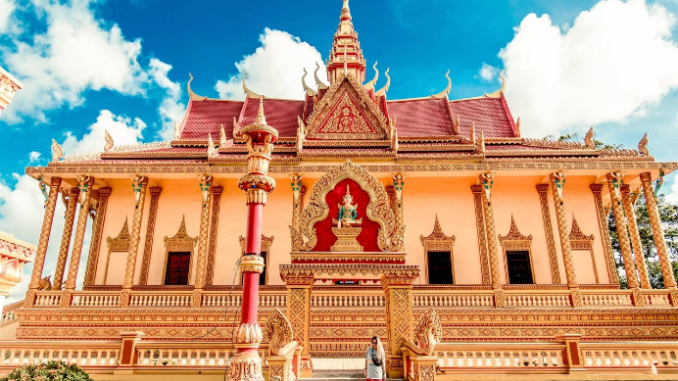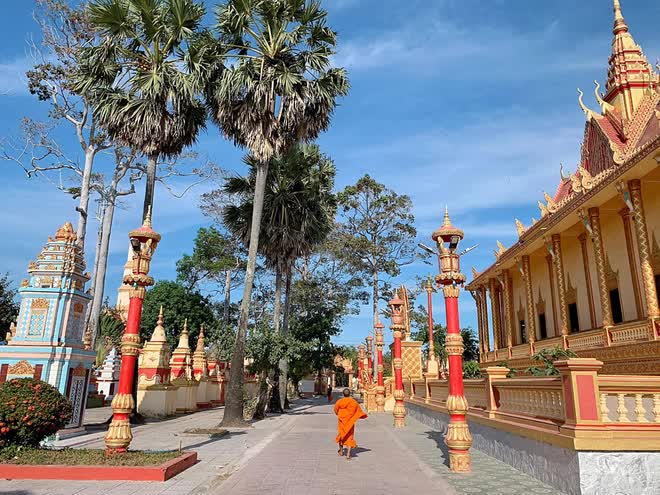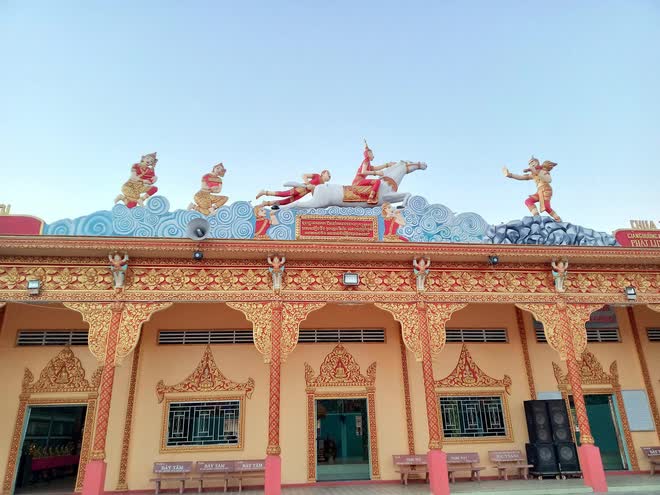
The beauty of the hundred-year-old pagoda with its unique and impressive architecture has made many tourists fascinated and nostalgic.
As an Asian country, one of the unique cultural features of our country is Buddhist belief. Currently, across the entire country, there are 18,491 temples, accounting for 36% of the total area. These temples are not only places where religious and cultural activities take place but are also interesting places to visit for tourists, especially foreign tourists.
Among nearly 20,000 temples, there are outstanding temples with historical stories behind them, unique architectural features or special locations. The pagoda named Xiem Can in Bac Lieu is an example. Images of Xiem Can Pagoda are shared on travel groups and forums and attract the attention of many interested tourists because the architecture is somewhat different from the majority of pagodas across the country.
Especially after Miss Phuong Khanh’s article with her pictures here, the pagoda received even more attention from tourists. In her article, Miss Phuong Khanh expressed: “Xiem Can Pagoda, a place that Khanh will never forget” .


The pictures Miss Phuong Khanh posted when she visited Xiem Can pagoda received a lot of attention (FBNV photo)
The most magnificent hundred-year-old pagoda in Bac Lieu with special architecture
The exact location of the pagoda is Bien Dong B hamlet, Vinh Trach Dong commune, Bac Lieu city. Located in the Southwest region, more than 200km from Ho Chi Minh City, it will take visitors about more than 5 hours to travel here. Besides the popular name Xiem Can Pagoda, the pagoda also has another name in Khmer language, Komphisako. It is a name that is still quite strange to tourists, but to the people of Bac Lieu as well as the people of the Mekong Delta, the pagoda is a familiar destination for religious activities, especially on holidays. festive occasion.
According to information on the page of the Propaganda Department, Bac Lieu Provincial Party Committee, Xiem Can Pagoda was built in 1887 with an initial area of 4500m2. So up to now, the pagoda is up to 136 years old. The Khmer name – Komphisako originally expressed the erudition and profoundness of Buddhist wisdom. Later, a part of the people who migrated here decided to translate it into the name Xiem Can – meaning “bordering the water”, reflecting the temple’s location near the coast, to make it easier to read and remember.

Overview of the campus of Xiem Can Pagoda (Western Travel Photo)
For more than a century, Xiem Can Pagoda has been considered the center of religious, cultural and artistic activities of the three ethnic groups Kinh – Khmer – Chinese in particular as well as the Buddhist community in Bac Lieu or other Buddhist communities. neighboring localities in the Mekong Delta region in general. In addition, this place is also one of the most beautiful and magnificent pagodas in Bac Lieu because of its special architecture.
In general, the architectural complex at Xiem Can Pagoda mostly faces east and was built according to the architecture of the Theravada school of Buddhism. The main color that visitors can easily see is yellow combined with red, characterized by pointed roofs, making the building stand out from afar. Intertwined among the buildings is the green color of trees and gardens, adding unique features to the overall Xiem Can pagoda.
Through the three-entrance gate of the pagoda, visitors will go through a tree-lined asphalt road before reaching the main hall. A special feature of the main hall is that instead of focusing on the front door, the doors on both sides are focused on opening wider, to avoid the morning sunlight shining directly into the shrine. Inside the hall are large murals depicting the life as well as the philosophies and lessons of Buddha, covering the entire space.

The three-entrance gate leading into Xiem Can Pagoda (Western Travel Photo)

Side view of the main hall of Xiem Can Pagoda (Photo Tripzone.vn)
After the ceremony and sightseeing in the main hall, visitors can leisurely go to other buildings such as the Xa Loi Tower, the Sala traditional house or areas with impressive statues, reliefs, and pillar systems. another within the temple grounds.
Every detail on the works of Xiem Can Pagoda is also extremely meticulous and sophisticated. These can be mentioned as the three-entrance gate, the wall system surrounding the temple, the reliefs, the towers and pillars or inside the main hall… On them are mainly engraved, sculpted, embossed or painted features. familiar images in Angkor architecture. From the images of monks, gods, and Buddha expressing majesty, to dragons, the magical bird Krut, a herd of elephants, or a winding 5-headed snake expressing mystery.

Inside the main hall (Mekong Expedition Photo)





Some pictures of other corners in Xiem Can Pagoda (Mekong Expedition Photos)
A place to organize unique cultural festivals
As mentioned above, Xiem Can Pagoda is considered the cultural and religious center of Bac Lieu people, especially during festivals. Every year, many unique festivals take place here with interesting activities, attracting not only pious Christians but also indigenous people or tourists from neighboring areas.
First is the New Year Ceremony – Chol Chnam Thmay, taking place from April 14-16 of the solar calendar; The ceremony to worship grandparents – Sen dolta, takes place from October 8-10 of the solar calendar or the saffron offering ceremony – Kathanhna takes place from September 16 to October 15 of the lunar calendar.
Visiting Xiem Can Pagoda during the festival, visitors will have more opportunities to participate in unique traditional activities with indigenous characteristics, thereby learning more stories about culture, history and customs. customs of the people here.

Visiting Xiem Can Pagoda on festive occasions, visitors will have the opportunity to learn more about cultural activities and customs here (Photo from Bac Lieu Provincial People’s Committee)
Because of the above unique cultural, historical and architectural features, Xiem Can Pagoda is increasingly becoming one of the prominent tourist symbols in Bac Lieu as well as in the region. In June 2022, the pagoda was officially recognized by the Mekong Delta Tourism Association as “Typical tourist destination in the Mekong Delta”. Previously, the pagoda was also classified as an architectural and artistic relic by the People’s Committee of Bac Lieu province in 2001.
Photo,Video: Internet (Vinlove.net)
